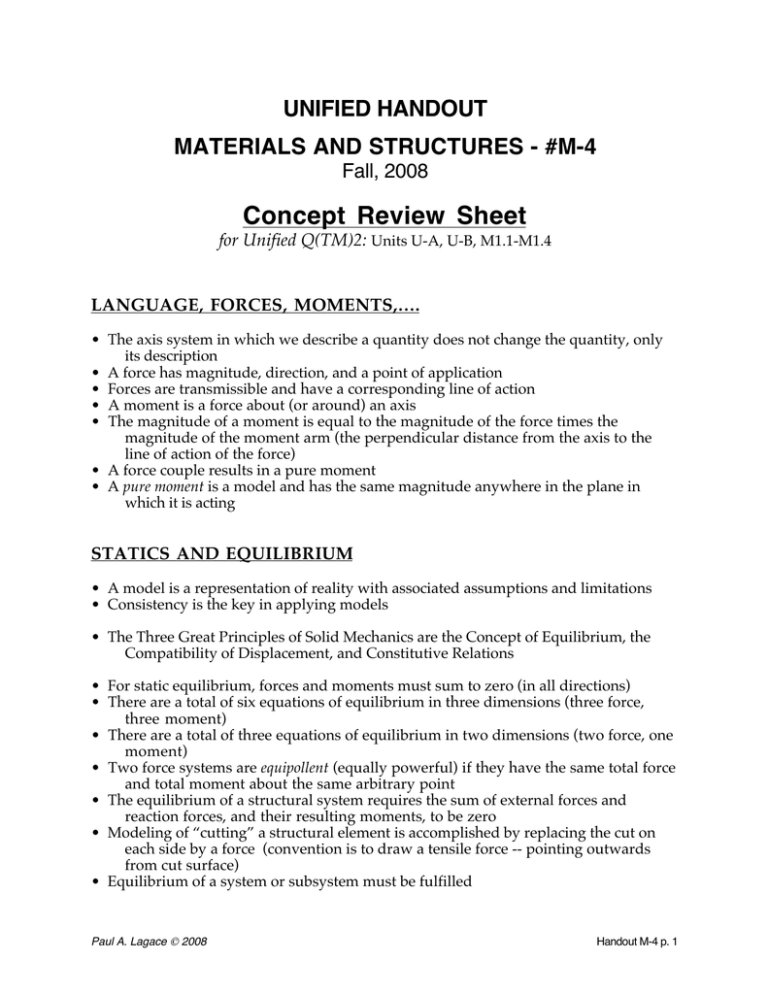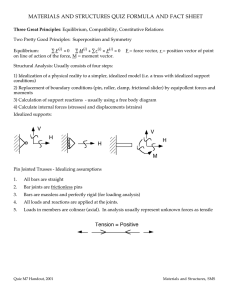Concept Review Sheet UNIFIED HANDOUT MATERIALS AND STRUCTURES - #M-4
advertisement

UNIFIED HANDOUT MATERIALS AND STRUCTURES - #M-4 Fall, 2008 Concept Review Sheet for Unified Q(TM)2: Units U-A, U-B, M1.1-M1.4 LANGUAGE, FORCES, MOMENTS,…. • The axis system in which we describe a quantity does not change the quantity, only its description • A force has magnitude, direction, and a point of application • Forces are transmissible and have a corresponding line of action • A moment is a force about (or around) an axis • The magnitude of a moment is equal to the magnitude of the force times the magnitude of the moment arm (the perpendicular distance from the axis to the line of action of the force) • A force couple results in a pure moment • A pure moment is a model and has the same magnitude anywhere in the plane in which it is acting STATICS AND EQUILIBRIUM • A model is a representation of reality with associated assumptions and limitations • Consistency is the key in applying models • The Three Great Principles of Solid Mechanics are the Concept of Equilibrium, the Compatibility of Displacement, and Constitutive Relations • For static equilibrium, forces and moments must sum to zero (in all directions) • There are a total of six equations of equilibrium in three dimensions (three force, three moment) • There are a total of three equations of equilibrium in two dimensions (two force, one moment) • Two force systems are equipollent (equally powerful) if they have the same total force and total moment about the same arbitrary point • The equilibrium of a structural system requires the sum of external forces and reaction forces, and their resulting moments, to be zero • Modeling of “cutting” a structural element is accomplished by replacing the cut on each side by a force (convention is to draw a tensile force -- pointing outwards from cut surface) • Equilibrium of a system or subsystem must be fulfilled Paul A. Lagace 2008 Handout M-4 p. 1 MIT, Unified (16.001/16.002) Materials and Structures Fall, 2008 • A Free Body Diagram isolates a body and identifies the system of forces (external and reactions) acting on it • There are three classes/categories of problems: dynamics (number of dof > number of reactions); statically determinate (number of dof = number of reactions); statically indeterminate (number of dof < number of reactions) • The force distribution can be determined just by applying the equations of equilibrium in a statically determinate system • Constitutive relations and compatibility of displacement must be applied to determine the reactions in a statically indeterminate system (simultaneously determine displacements) TRUSSES • A truss is a structural configurations in which bars are connected at joints and the overall configuration carries load through axial force in the bars • The model of an idealized truss assumes that: (1) all bars are straight, (2) bar joints are frictionless pins, (3) bars are massless and perfectly rigid (for loading analysis), (4) all loads and reactions are applied at the joints, (5) loads in members are colinear (axial -- aligned with long axis of bar) • Bar joints do not carry/transfer moments • In the Method of Joints, a joint is isolated and force equilibrium applied to the resulting free body diagram at that joint • In the Method of Sections, a section of the truss is cut and force and moment equilibrium applied to the resulting free body diagram Paul A. Lagace 2008 Handout M-4 p. 2






